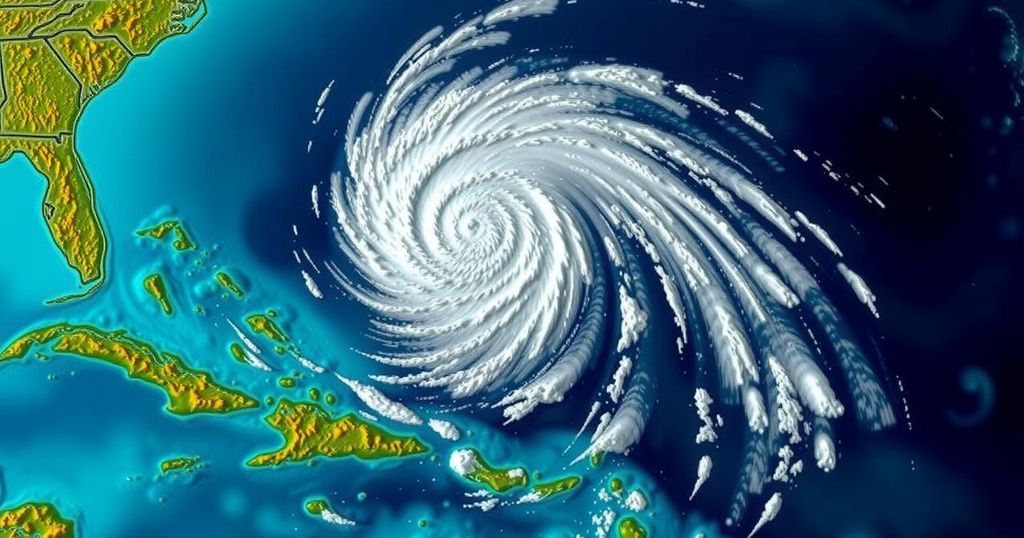The Unpredicted Evolution of Hurricane Oscar: A Case Study in Forecasting Challenges

Hurricane Oscar rapidly intensified from a tropical wave with only a 10% chance of development to a Category 1 hurricane in the Bahamas within a day, primarily due to limitations of computer models that failed to predict its evolution. Human forecasters, however, were able to recognize the storm’s potential through satellite data and timely reconnaissance flights, enabling adequate warnings despite minimal lead time for preparation.
On Friday evening, a turbulent tropical wave east of Puerto Rico carried a mere 10% prospect of intensification over the weekend. However, by Saturday afternoon, this wave had evolved into Hurricane Oscar, a Category 1 storm poised to impact the Bahamas. What transpired during this rapid transformation was a noteworthy deviation from standard predictions by computer models, which largely overlooked the storm’s potential. Nonetheless, diligent human observation and data collection enabled forecasters and researchers to raise alarms in time to alert the affected regions. Philippe Papin, a prominent forecaster at the National Hurricane Center, identified peculiarities in the satellite imagery, particularly the passive microwave data revealing a low-level circulation characteristic of developing tropical storms. Papin expressed, “It became pretty clear that a small circulation was developing. We had to shift gear in a short period of time.” Promptly responding to the situation, the hurricane center issued its first forecast for Tropical Storm Oscar by 11 a.m., including a predictive cone indicating its trajectory toward the Bahamas and Cuba, leading to the issuance of tropical storm warnings across the Bahamas. Concurrently, a hastily assembled team of Hurricane Hunters, departing from St. Croix, sought to gather crucial atmospheric data. Their reconnaissance revealed a system that had significantly intensified compared to previous observations, with storm-force winds only detected as their aircraft neared the storm’s center. By 2 p.m., Tropical Storm Oscar was officially upgraded to Hurricane Oscar, marking it as one of the smallest hurricanes recorded in the Caribbean, which afforded the islands less than one day of preparation for the hurricane’s landfall. Papin remarked, “The typical time for issuing a watch is 48 hours of lead time. This was more like 12 to 24 hours. Obviously that is sub-optimal.” Hurricane Oscar ultimately made its presence felt on Great Inagua Island in the Bahamas early Sunday morning and continued toward Cuba by the evening. The initial formation of what would become Hurricane Oscar took place as the system departed the African coast over a week prior. Although early computer models indicated a reasonable chance for the system to develop into a tropical depression, they later underestimated the system’s potential, attributing its decline in strength to a surge of dry air. By the end of Friday, major forecast models no longer anticipated tropical development in the Caribbean or Atlantic for the following week. Phil Klotzbach, a senior research scientist at Colorado State University, noted, “I think the models just had a hard time resolving the circulation before they got the recon in there. It’s not like the models didn’t have signals, they had them and then it killed them off.” Subsequent data acquired from the Hurricane Hunters was integrated into computer models, which soon began tracking Hurricane Oscar. It is noteworthy that while the storm was categorized as small, it still presented unique challenges for forecasting due to its diminutive size and a limited radius of hurricane-force winds, which only extended five nautical miles from the storm’s center. Klotzbach indicated the difficulty in forecasting such small storms, stating, “Even though it’s low, they always had a 10% chance. You just never know. It’s a tough forecast. These small storms are tricky.”
The phenomenon of hurricanes is complex, greatly influenced by various environmental factors, including the presence of moisture and atmospheric dynamics. Forecasting these storms relies heavily on computer models, which assimilate vast quantities of meteorological data to predict future developments. Nevertheless, the precision of these models can falter, especially with smaller systems that may not fit neatly within these predictive frameworks. The case of Hurricane Oscar serves as a prime example of how rapid intensification can go undetected by automated systems, necessitating human intervention and real-time analysis to avert disaster and enable timely preparedness within vulnerable regions.
In conclusion, the extraordinary transformation of a minor tropical wave into Hurricane Oscar within a brief time frame epitomizes the challenges faced by meteorologists in accurately forecasting tropical storm intensification. While computer models played a significant role in the prediction process, their inability to resolve Oscar’s rapid development underscores the critical importance of human observation and data collection. This incident serves as a reminder of the unpredictability of small storms and the ongoing need for refined forecasting methodologies to improve readiness in the face of unpredicted weather events.
Original Source: www.miamiherald.com






